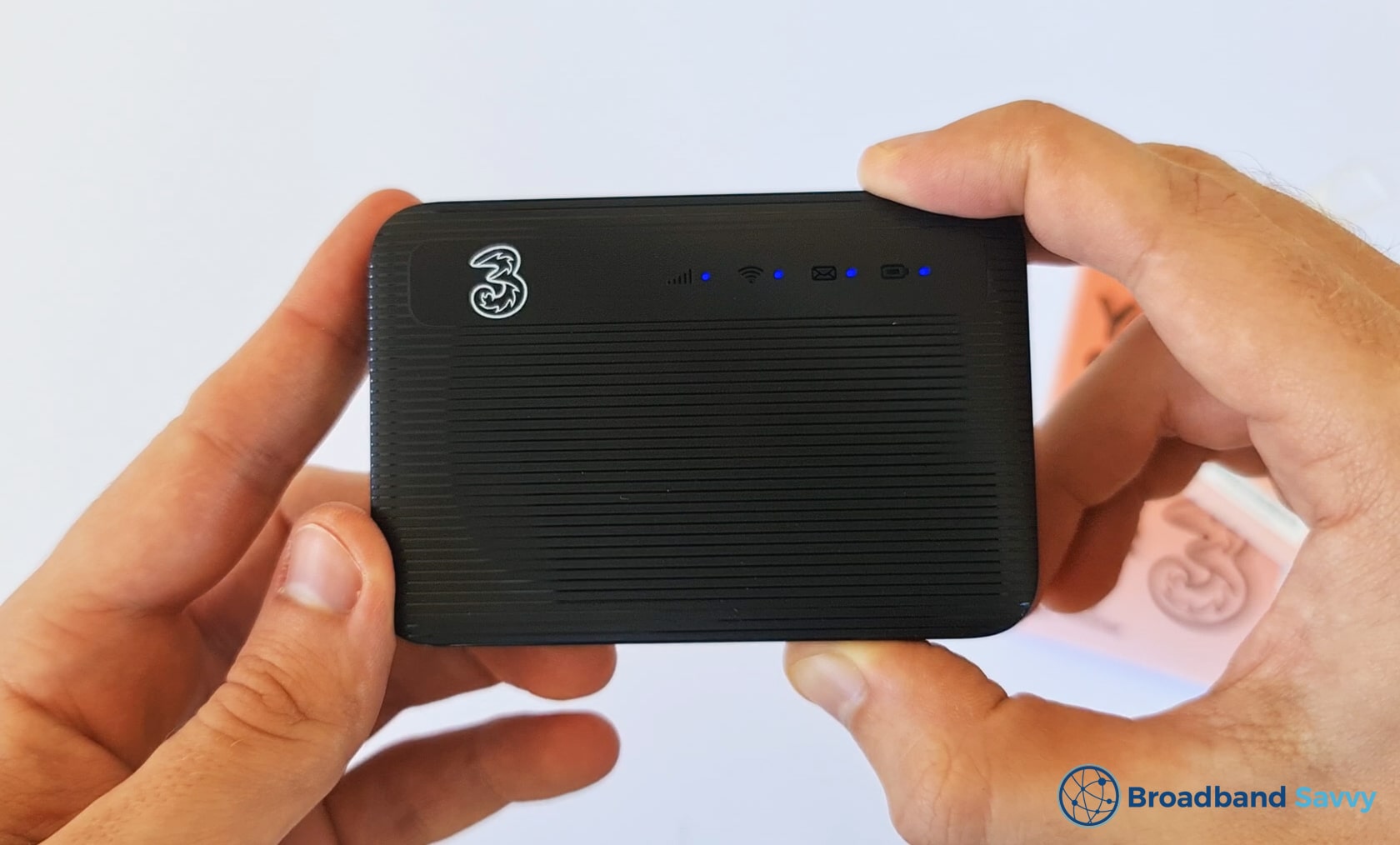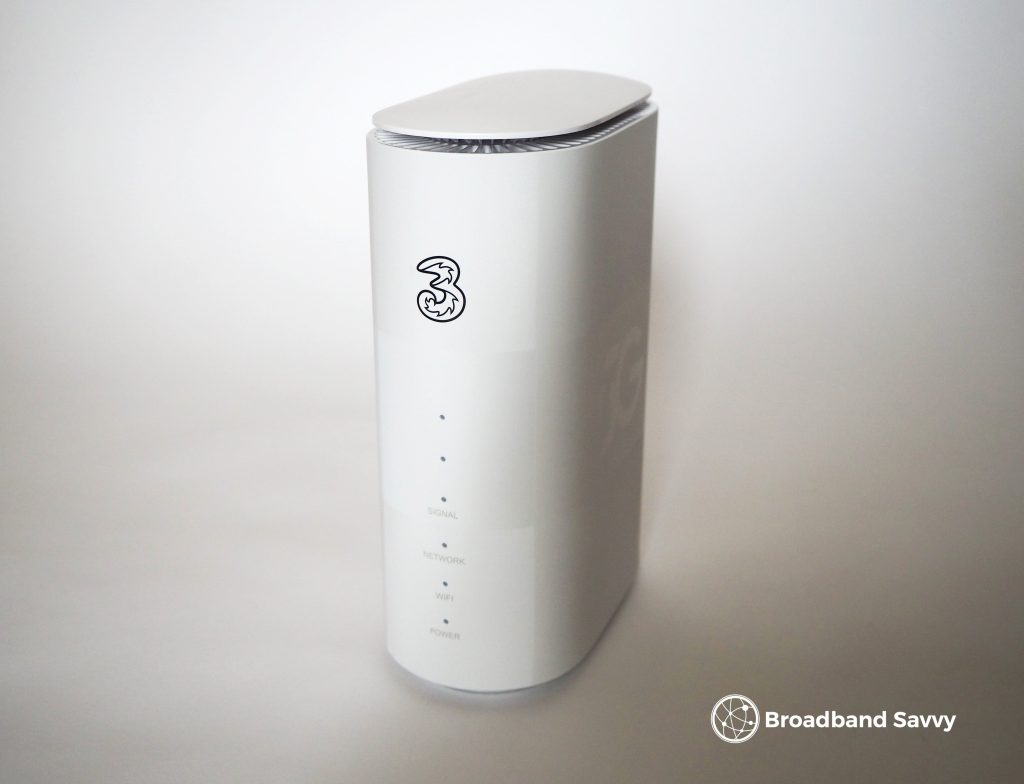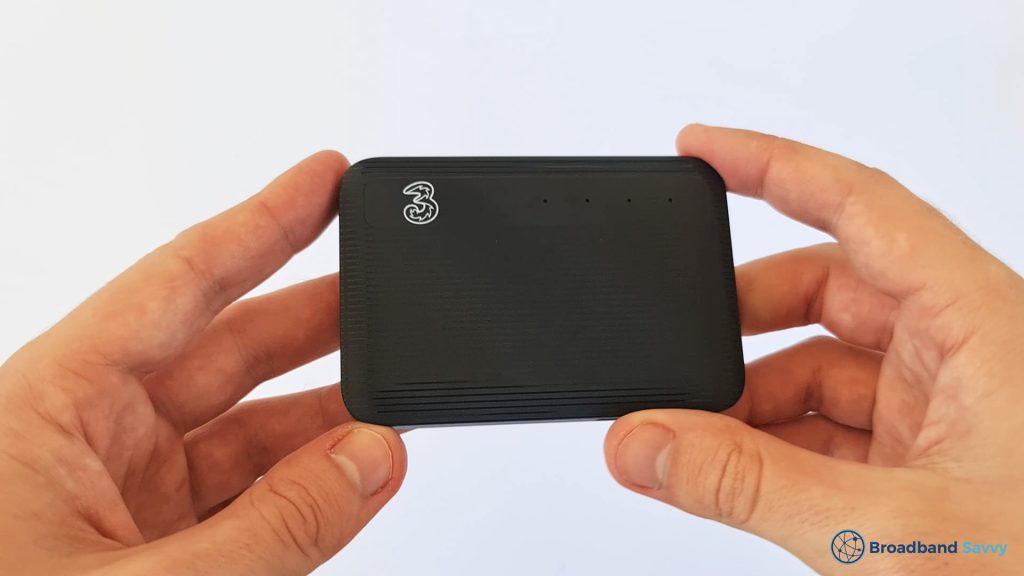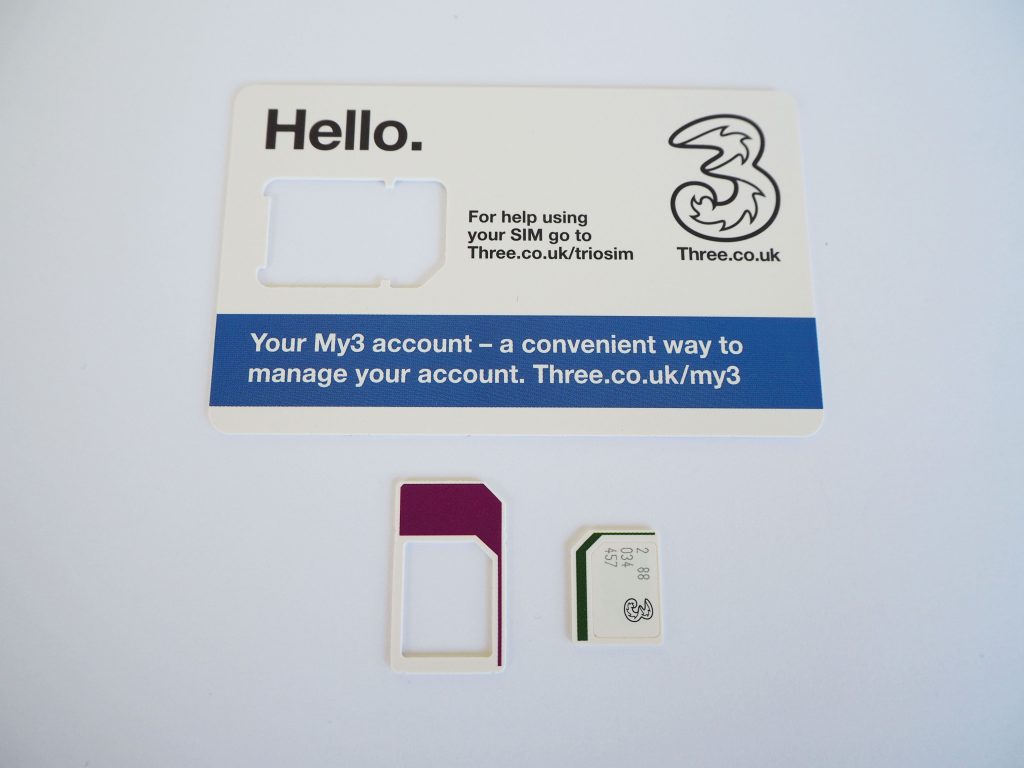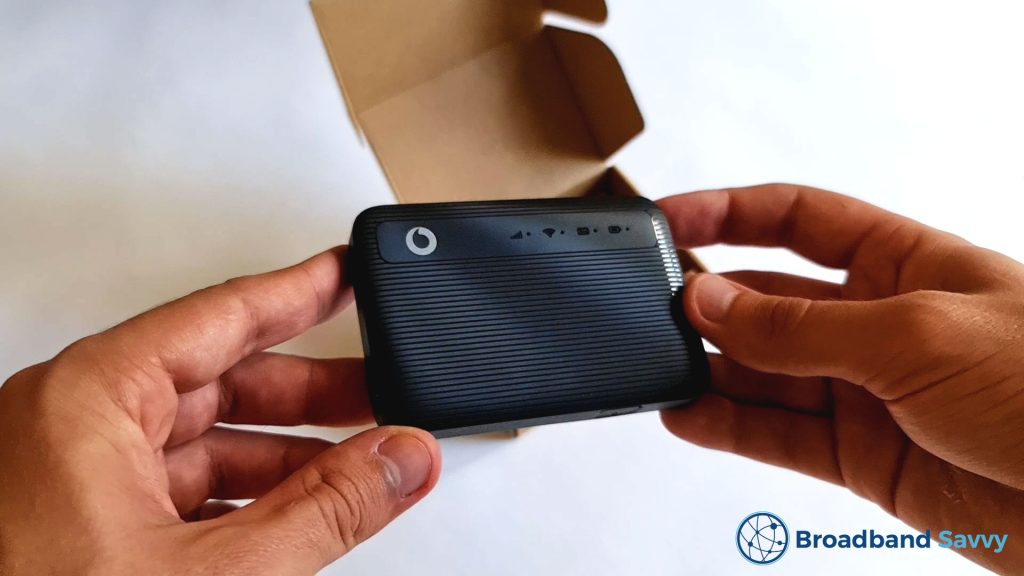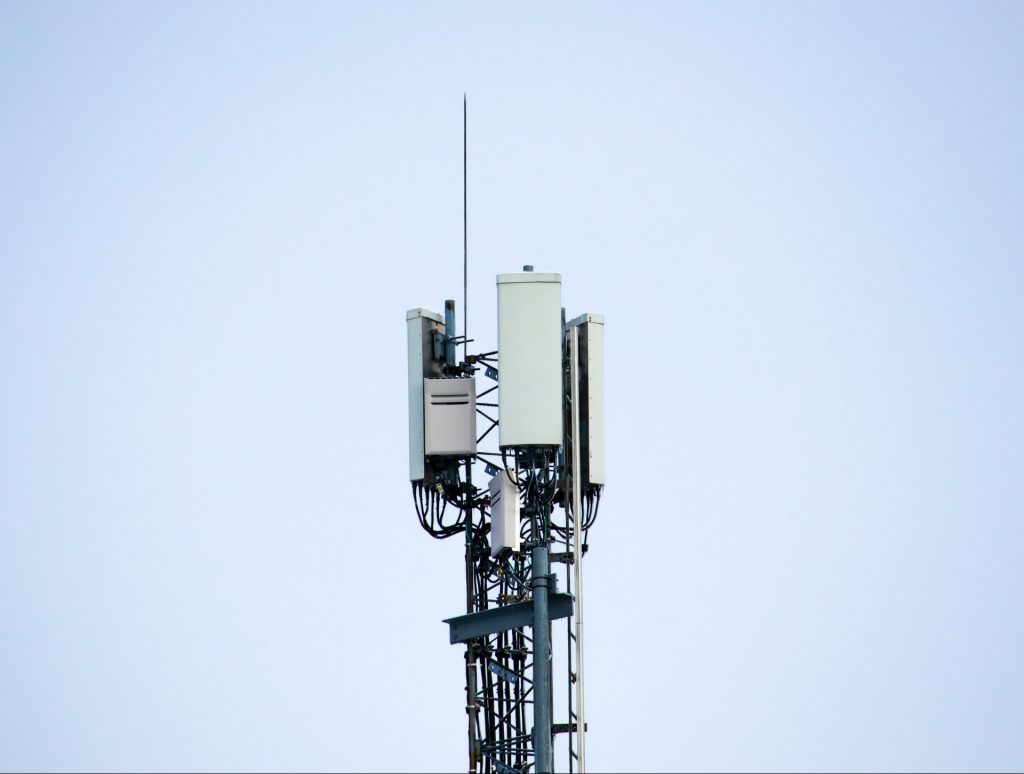Need a portable way to get online in multiple different locations?
In this guide, we’ve reviewed some of the best portable WiFi solutions on the market in the UK in 2026.
We’ve also explained how to choose the right product for your specific needs, given how you need to get online.
Best portable WiFi solutions
In this part, we’ve looked at some of the best ways to get a portable internet connection, and explained when each solution makes the most sense to use.
1. Three 5G Hub Router
Three currently sells a WiFi router that comes with a SIM card and a 5G antenna, rather than connecting to a broadband socket.
Although it’s called the 5G Hub, this router can connect to the internet with 4G as well, meaning you can get online almost anywhere in the UK with mobile signal.
It comes with unlimited data, unlike most other mobile broadband solutions, and is very reasonably priced, given it offers 5G connectivity.
You can also try out this router for 30 days after buying, and return it if you’re not quite happy with the device. This gives you a decent window of opportunity to test the router in different locations you travel to, before committing to using it.
Plus, even though the router itself is quite an expensive bit of kit, Three offers a 1 month contract on their 5G broadband deals, which is great if you want extra flexibility. The default contract, which is cheaper, has a 24 month commitment.
As long as Three has good signal where you travel (check using their coverage map), and you can plug the router into mains electricity, the Three 5G Hub is a great choice if you want portable broadband.
Pros
- Great value.
- Comes with unlimited data.
- Offers fast 5G speeds in 5G areas.
- 1 month contract available.
Cons
- Needs mains power at all times.
2. Three TCL MiFi Device
If you need a portable Wi-Fi solution that doesn’t need to be plugged into the mains, Three’s mobile Wi-Fi (MiFi) device is worth looking at.
This mobile Wi-Fi router comes with a battery, which offers about 6-8 hours of use on a single charge. This means this device can be used in your car, at a cafe, or in other locations where you can’t really plug in a router.
Three’s MiFi device is also very small, making it convenient to travel with. This also helps to keep the cost of the router quite low, especially if you choose one of Three’s plans with a data limit.
There are lots of deals available, and you can choose between a pay monthly 12 or 24 month contract, or a pay as you go month-to-month agreement.
However, compared to a proper router, this MiFi device doesn’t offer quite as good speeds or Wi-Fi signal. It’s not the best choice if you want the fastest possible download speeds, or need to get online with many different devices at the same time.
Ultimately, Three MiFi is a great choice if you need the best possible portability. But if possible, getting a 5G router is often a better option.
Pros
- Very portable – comes with a battery.
- Lots of flexible deals available.
- Low monthly cost.
- Small, lightweight, and easy to travel with.
Cons
- Not the best WiFi signal, especially with more than two devices online.
- Limited to 4G speeds.
3. Vodafone 5G MiFi
For those who want fast speeds, and need a battery-powered hotspot, Vodafone MiFi is definitely worth considering.
This is another MiFi device, like what Three offers, but it’s 5G compatible, rather than just 4G. Meaning, you should be able to get download speeds of 300 Mbps or even higher using this device, depending on how good Vodafone 5G signal is in your area.
The downside to this is, Vodafone MiFi is a lot more expensive than the device Three offers, especially if you want a 30-day contract. It’s even more expensive than Three’s 5G Hub router.
However, as well as the higher speeds, this router is also capable of handling more concurrent connections, at up to 32 devices on WiFi 6. If you’re getting 5G speeds, you should be able to ensure a smooth experience, even with multiple people online.
The battery life is also quite good on this device, at 8 hours of usage, and you can keep it plugged in when charging if you want to.
We just wish this device wasn’t so expensive compared to Three MiFi.
Pros
- Offers 5G speeds.
- Good Wi-Fi performance.
- Long battery life.
Cons
- Expensive.
4. Three Data SIMs
Rather than buying a separate portable WiFi solution, you might also like to use your phone’s hotspot to get online on the go.
To do this, it might make sense to upgrade your SIM to a higher data limit. At the moment, Three tends to offer the best value on data SIM cards, and they include 5G connectivity by default as well.
Three supports eSIMs, meaning you can buy a separate data SIM to use as your hotspot, and activate it virtually, without having to take out your existing SIM card.
On most phones, you can install the SIM by scanning a QR code, and decide when to switch between each SIM in your device settings.
There are downsides to using your phone’s hotspot to get online on the go though. If you do it on a regular basis, you’ll wear out your phone’s battery, because having the hotspot on is very power-intensive.
You’ll also need a 5G-compatible phone, to ensure the best possible download and upload speeds. And using a phone hotspot is only really suitable for getting online on one or two devices at the same time.
However, hotspotting is very convenient, and it can be cheaper than buying a MiFi device, even if you need to get a new SIM card.
Pros
- Convenient way of getting online.
- Three offers 5G speeds free of charge.
- Good value data plans.
Cons
- Can be hard on your phone’s battery life.
5. Starlink Roam
Satellite broadband isn’t normally a good option if you’re looking for a portable way to get online.
Most satellite internet companies only allow you to get online at your home address. And often, when you move the satellite dish, it needs to be recalibrated to ensure you still get good speeds.
However, Starlink has recently begun to offer a Roam package, which supports getting online in multiple locations. You can self-calibrate the satellite dish using the Starlink mobile app.
Starlink Roam is great if you need to travel to places with no 4G or 5G signal – you can get online almost anywhere, as long as you have a clear view of the sky.
They also offer the ability to get online in motion, when driving or even on a boat, as long as you install their high-performance dish on your vehicle.
The downside is, Starlink, and in particular their Roam package, is extremely expensive compared to using 4G or 5G.
Also, this plan doesn’t offer the best speeds – Starlink Roam is slower than what their regular internet packages offer.
Pros
- Works in areas with no 4G or 5G signal.
- Available across the entire UK.
- Allows you to get online in-motion, with the right dish installed.
Cons
- Very expensive.
- Speeds are limited compared to regular Starlink.
What you need to know
In this part of the article, we’ve explained some key things to consider when shopping for a portable Wi-Fi solution.
Common portable WiFi use cases
Here are some of the most common reasons you might need portable WiFi, and which type of solution works best in each scenario.
- Caravans: 4G or 5G routers are generally the best choice since they offer better signal than using a portable hotspot, and most caravans have mains electricity. Starlink can also be an option, although it’s not cheap. Read our guide to caravan WiFi to learn more.
- Cars: MiFi is generally a good choice, since most motorways do not have 5G signal, you can use a cheaper device like Three’s TCL MiFi.
- Regular travel between AirBNBs/hotels: 5G routers generally work well, since most hotels and AirBNBs will have at least 4G mobile signal.
- Working on the go, at job sites/digital nomadding: mobile Wi-Fi or phone hotspots are best, because you don’t need to be plugged in all the time.
- Camping: MiFi can be a good choice as long as you can recharge the device and have at least good 4G signal. Starlink will work as well, but is expensive.
- Moving house: 5G routers are a good choice if both houses have 4G/5G signal.
Routers vs MiFi
If possible, getting a router is generally a better choice than a mobile Wi-Fi (MiFi) device.
- They offer better WiFi signal, and faster download speeds.
- They’re better for getting online with multiple devices, and offer a more consistent connection.
- They’re cheaper, if you want 5G speeds (5G MiFi devices can be very expensive).
However, MiFi is a better choice if you need a battery-powered hotspot, as long as you only need to get online with one or two devices at the same time.
You can always keep your MiFi device plugged in and charging all the time, if you end up staying in one place for an extended period.
How much data do I need?
Since most portable WiFi solutions use 4G or 5G technology to connect you to the internet, they often come with a data limit.
The amount of data you need depends on how many people will be using the connection, and what sort of things you’ll be doing online.
- For occasional use every few days, for one to two people, 30GB should be a high enough monthly limit.
- For daily use for one to two people, you’ll want 50-100GB of monthly data, or possibly more if you often watch a lot of videos or download large files, or are online for more than four hours a day on a regular basis.
- For daily use for two or more people, especially if you watch a lot of videos or work from home, you will most likely need unlimited data.
If you don’t tend to watch a lot of videos, you might be able to get away with a lower data limit.
For context, if you watch an hour of 1080p Netflix every evening for a month, this will use approximately 40-60GB of data, just on its own.
Most couples and families need unlimited data in this day and age – simply because of the amount of video content we consume on Netflix, YouTube, Amazon Prime, and social media platforms like Instagram.
How much will I pay for portable internet?
If you get a mobile broadband router like the Three 5G Hub, you can expect to pay £25 per month or so.
For a 4G MiFi device, you’ll probably pay a similar amount, depending on how much monthly data you need. You might have to pay a higher upfront cost if you choose a pay as you go contract.
SIM cards can be very cheap, running as little as £15-£20 per month, even with unlimited data. Your monthly cost will be lower if you commit to a 12 or 24 month contract.
With 5G MiFi, the upfront costs can be very high on short-term contracts, since these devices are currently so expensive. If you choose a 24 month contract though, you might be able to get the device with no upfront fee, since the cost will be apportioned over the life of the contract.
Starlink broadband will cost in the region of £300 for the satellite dish, then £80 per month or so for their Roam internet service.
Can you use satellite broadband for portable internet?
Unfortunately, it’s not generally possible to use satellite internet as a portable broadband solution, such as by attaching a dish to your caravan, or taking one with you when camping.
When installing satellite internet, the dish needs to be calibrated at a very specific angle, and professional installation is often required.
Most satellite broadband companies expect you to only use the service at a single address, and don’t allow you to move locations with the satellite dish installed.
The only real exception to this is Starlink’s Roam product. It allows you to self-calibrate the satellite dish in different places you might be using it, allowing you to get online in multiple locations. However, it is very expensive, and has slower speeds than Starlink’s regular internet service.
4G vs 5G portable Wi-Fi
In many situations where you’re using portable internet, you’ll have to rely on 4G technology to get online.
5G is normally only available in urban locations, and certain suburban areas in the UK. Fortunately though, most 5G compatible routers also support 4G, so even if you’re not always going to be in a 5G area, it’s often worth paying a bit more for a mobile broadband solution that supports 5G.
Using 4G, you can generally expect download speeds of 20-50 Mbps. With 5G, you can often get speeds of 200-300 Mbps or even higher.
The big advantage of 5G for most people is it allows multiple people or devices to get online without suffering from slowdowns, or lag.
With a 20-30 Mbps 4G connection, if more than two people get online and begin doing data-intensive activities, such as watching videos, your connection will quickly slow down for everyone.
Which mobile network is best?
Three and EE generally perform very well when it comes to 5G speeds and availability.
But in terms of 4G coverage, especially in remote areas, EE is the UK market leader. The problem is, their SIM plans can be very expensive, and their 5G broadband product has the same issue.
Since Three offers good speeds, and is so much more price competitive than all of the other networks, they’re often the best choice.
It’s a good idea to check their coverage map at some of the places you’ll be travelling to, to see if Three has coverage in these areas.
Conclusion
This is the end of our portable internet buyer’s guide.
If you’re not sure which type of portable internet device to buy, leave a comment below, and we’ll get back to you as soon as possible.
About the author

Tyler is the co-founder of Broadband Savvy. He has been helping people improve their broadband connectivity since 2018 by writing about fibre broadband and mobile broadband providers, as well as creating tutorials to help people improve their broadband speeds and Wi-Fi signal.
Tyler is responsible for the majority of buyer’s guides and broadband reviews published on Broadband Savvy. He has a wealth of experience testing and reviewing different broadband tariffs, including fibre internet plans, as well as 4G and 5G broadband deals. He is responsible for testing and evaluating Wi-Fi routers, performing speed and latency tests, and comparing the value for money of different broadband providers on the market in the UK.
Before co-founding Broadband Savvy, Tyler had a long history of tinkering with computers. He built his first PC at the age of 12, and since then, he’s become obsessed with all things networking and internet-related. He’s a massive gamer, loves Rocket League, and also plays Sunday League football.

